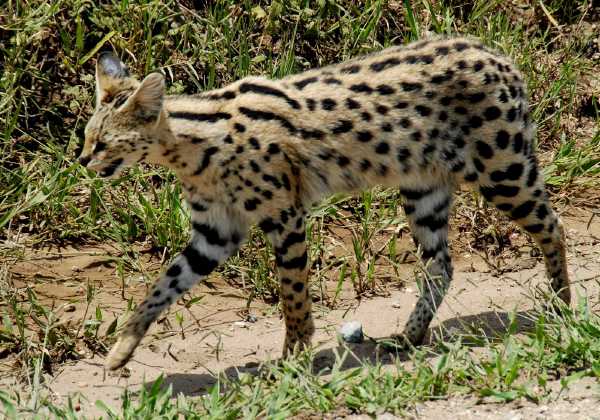 Serval ServalLeptailurus
serval
Description
The serval has the longest ears and legs
relative to overall size of all cats, as well as
a long neck and relatively small head. It is a
medium-sized cat, with a body length of 23-36
inches, height of 21-26 inches, and weight of
19-40 pounds.
The generally light brown fur is covered with
black spots and stripes, the pattern of which is
unique to each individual animal. Markings start
on the top of the head, running between the ears
and down the neck and forming four distinct
stripes which break into spots on reaching the
shoulders. The serval's relatively short tail is
banded with black rings and ends in a black tip.
Individuals that originated from grasslands tend
to have larger spots than those found in forests.
Distribution and
Habitat
The greatest numbers of servals reside in
southern Africa, especially in Zimbabwe and the
province of Natal. Small populations are located
in the Atlas Mountains, as well as Algeria,
Morocco, Ethiopia, and south of the Sahara. Due
to relocation efforts, members of this species
can also now be found in northern Tanzania
They are most commonly found in reed beds and
grasslands, but also spend time in forest brush,
bamboo thickets, marshes, and streams within
their home range.
Diet
Servals hunt primarily during the early
morning and late afternoon, and occasionally at
night. Over 90% of the diet consists of small
mammals (especially rodents), with birds (caught
both on the ground and by leaping up to 9 feet
into the air), insects, reptiles, and rarely
carrion.
To begin hunting, a serval first scans the
surrounding area. Ideal hunting spots are located
along roads or trails, where there is good
audibility on all sides and less noise is made
when walking. If prey is detected, the ears prick
up and rotate to pinpoint its location. Once the
location of prey has been established, the serval
slinks forward and then suddenly pounces. The
prey is held down with the front paws until a
death bite is delivered to the neck. If prey is
heard beneath the soil, a serval will rummage,
dig, and sniff to either reach or flush the
critter out. One of the best hunters in the cat
family, servals make a kill in about half of all
tries, compared to an average of only one of
every five or six attempts for other cats.
Reproduction
The territories of males overlap with those of
as many females as possible for optimal
reproduction. Although there is no set breeding
interval, mating occurs more often in the spring.
A female nearly ready to breed will hunt and
court the male over several days.
After mating, the female looks for a suitable
den in which to give birth and raise her young.
Dens vary from dense shrubs to holes under rocks
or abandoned burrows. Two or three kittens are
born after a gestation period of 10-11 weeks. The
kittens double in size within their first 11
days, are weaned at about 5 months, and are
independent by the end of their first year. All
parental care is provided by the mother.
Servals have an average lifespan of about 10
years in the wild.
Other Habits and
Behaviors
Servals are not social, but in some cases,
when a male and female encounter each other, they
may travel, hunt, and rest together for short
periods.
Both sexes maintain territories, the
boundaries of which are scent marked. Female
ranges do not overlap with other females, but may
overlap with those of several males.
Like many other cats, servals are good tree
climbers. Unlike many cats, they will happily
wade into water after prey.
Scientific
Classification
phylum Chordata
subphylum Vertebrata
class Mammalia
order Carnivora
family Felidae
genus & species Leptailurus serval

Animal Diversity Web http://animaldiversity.org/accounts/Leptailurus_serval/
Questions or comments about
this page?
|



